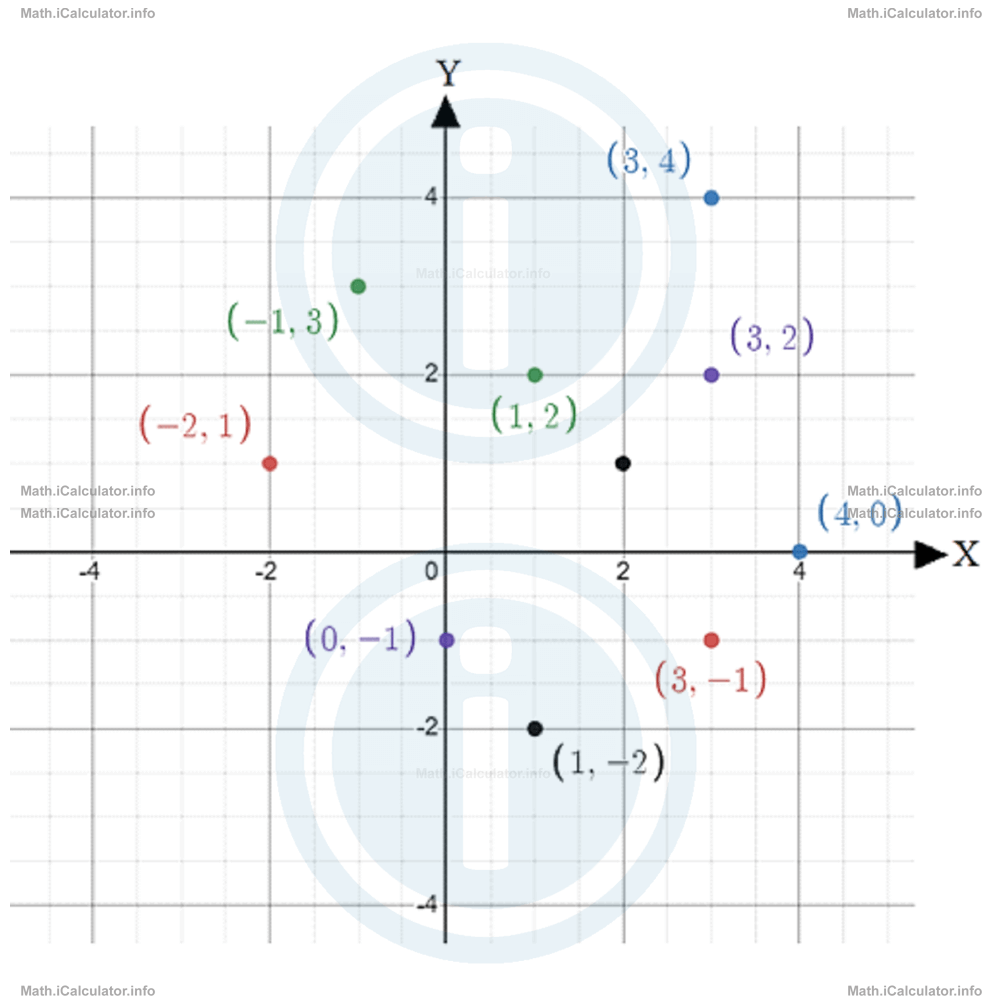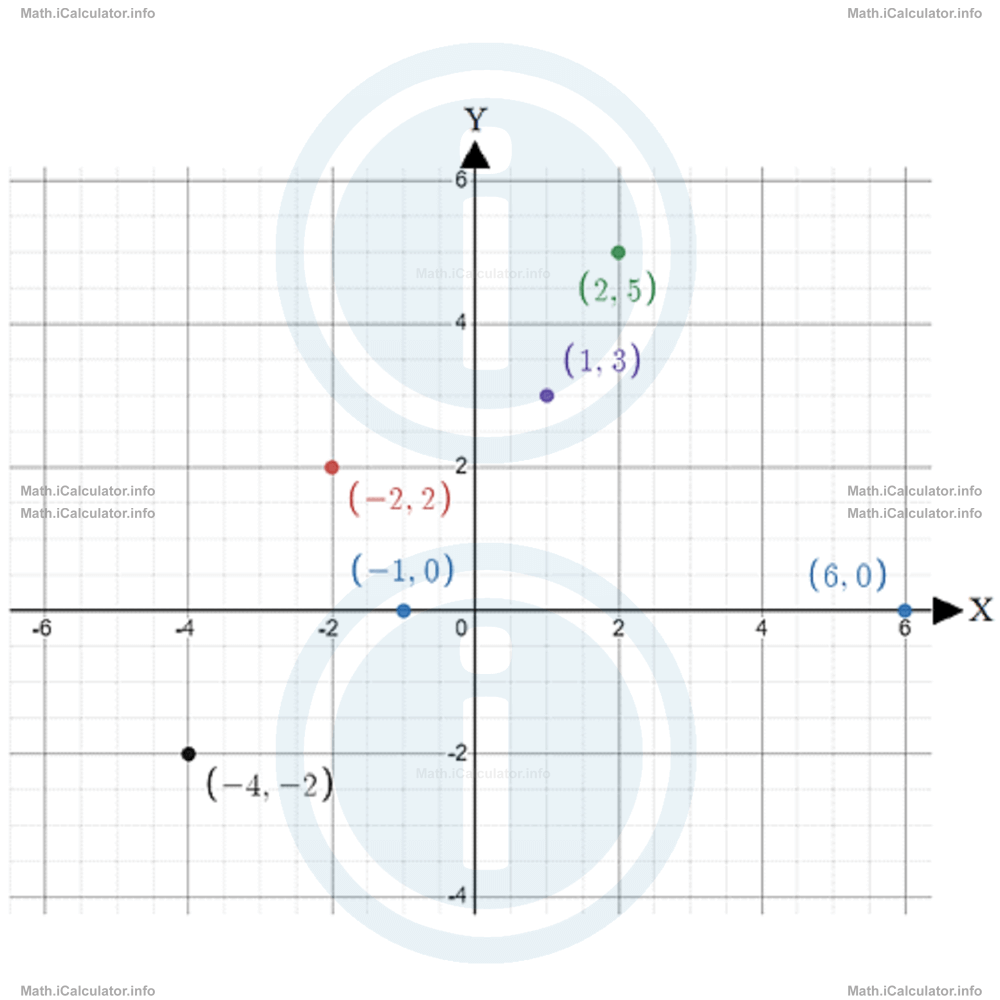Menu
Math Lesson 16.1.1 - Ordered Pair
Please provide a rating, it takes seconds and helps us to keep this resource free for all to use
Welcome to our Math lesson on Ordered Pair, this is the first lesson of our suite of math lessons covering the topic of Relation and Function, you can find links to the other lessons within this tutorial and access additional Math learning resources below this lesson.
Ordered Pair
We learnt in previous tutorials that a graph shows an infinite number of points that are very close to each other, so we cannot see the spaces between these points but only a solid line. All the above-mentioned points represent pairs of coordinates written in brackets, where the first coordinate of any number pair is always the horizontal one while the second coordinate is the vertical one. For example, if one says A(2, -3) is a point of a graph, we understand that the x-coordinate of the point A is xA = 2 and the y-coordinate of the same point is yA = -3.
In mathematics, an ordered pair is a set of two numbers usually written in the form (a, b). These two numbers are taken from different sets, usually determined by values in the two perpendicular number axes - the horizontal and vertical ones. The order of the two numbers is important in the sense that (a, b) is different from (b, a) unless a = b. As stated earlier, ordered pairs are commonly used to specify a location on a coordinate plane.
Thus, if we consider the following set of ordered pairs given
we understand that four points from a given graph in the coordinates system are given, where the x-coordinates of these four points are -1, 0, 1 and 2 respectively while the corresponding y-coordinates are 3, -1, 4 and -3.
Ordered pairs are not always connected through lines. In many cases, they are disconnected points in the coordinate system. This occurs when the data set shown on the graph represents the relationship between the variables through scattered points, as in the figure below.

Example 1
- Show the following ordered pairs on the coordinates system (-2, 2), (-1, 0), (2, 5), (1, 3), (-4, -2), (6, 0)
- Calculate the distance between the remotest points determined by the ordered pairs above.
Solution 1
- Given that the first number of an ordered pair represents the x-coordinate and the second number the y-coordinate of the corresponding point, we obtain the following figure for all points determined by each number pair.

- From a first glance at the figure, there is a doubt whether the remotest points are (-4, -2) and (6, 0) or (-4, -2) and (2, 5). We use the distance formula d = √(x2 - x1 )2 + (y2 - y1 )2to calculate the distance between each of the pairs of numbers. Thus, for the first option (-4, -2) and (6, 0) we haved1 = √(6 - (-4))2 + (0 - (-2))2and for the second option (-4, -2) and (2, 5) we have
= √(6 + 4)2 + (0 + 2)2
= √102 + 22
= √100 + 4
= √104d2 = √(2 - (-4))2 + (5 - (-2))2Since √104 > √85, then the remotest points are those with coordinates (-4, -2) and (6, 0).
= √(2 + 4)2 + (5 + 2)2
= √62 + 72
= √36 + 49
= √85
You have reached the end of Math lesson 16.1.1 Ordered Pair. There are 9 lessons in this physics tutorial covering Relation and Function, you can access all the lessons from this tutorial below.
More Relation and Function Lessons and Learning Resources
Whats next?
Enjoy the "Ordered Pair" math lesson? People who liked the "Relation and Function lesson found the following resources useful:
- Ordered Pair Feedback. Helps other - Leave a rating for this ordered pair (see below)
- Functions Math tutorial: Relation and Function. Read the Relation and Function math tutorial and build your math knowledge of Functions
- Functions Revision Notes: Relation and Function. Print the notes so you can revise the key points covered in the math tutorial for Relation and Function
- Functions Practice Questions: Relation and Function. Test and improve your knowledge of Relation and Function with example questins and answers
- Check your calculations for Functions questions with our excellent Functions calculators which contain full equations and calculations clearly displayed line by line. See the Functions Calculators by iCalculator™ below.
- Continuing learning functions - read our next math tutorial: Injective, Surjective and Bijective Functions. Graphs of Functions
Help others Learning Math just like you
Please provide a rating, it takes seconds and helps us to keep this resource free for all to use
We hope you found this Math tutorial "Relation and Function" useful. If you did it would be great if you could spare the time to rate this math tutorial (simply click on the number of stars that match your assessment of this math learning aide) and/or share on social media, this helps us identify popular tutorials and calculators and expand our free learning resources to support our users around the world have free access to expand their knowledge of math and other disciplines.